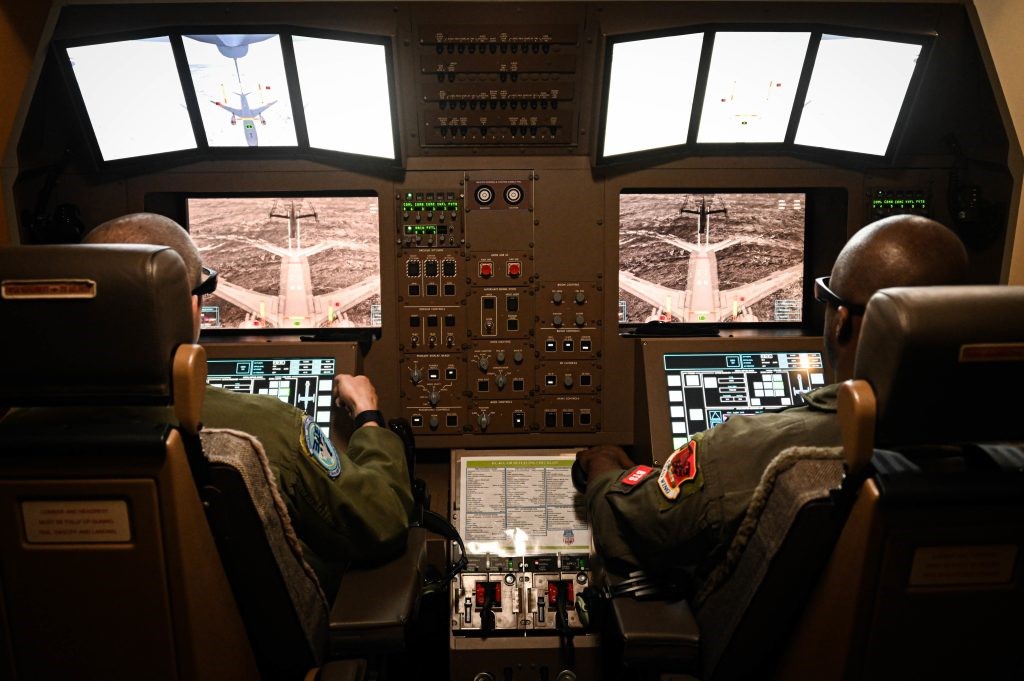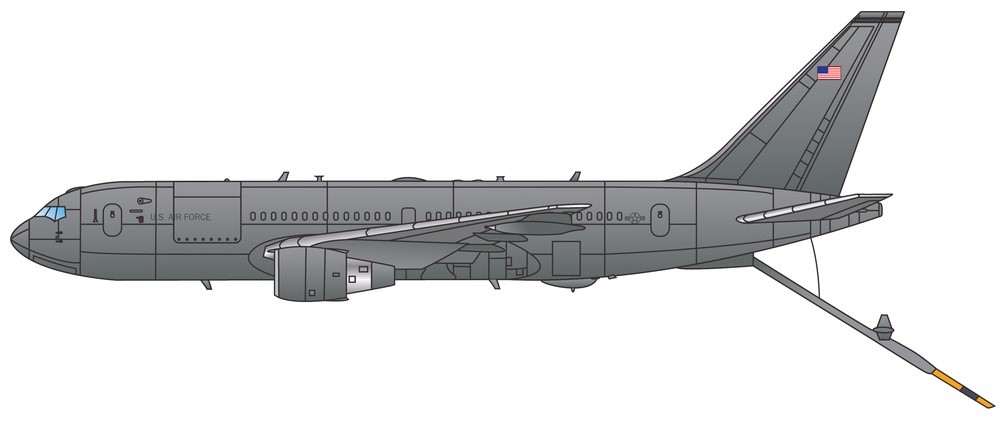As the United States Air Force (USAF) prepares to retire its aging fleet of KC-10 Extender tankers, a new era of air-to-air refueling technology is on the horizon. The retirement of the KC-10 marks a significant transition, heralding the rise of the next-generation KC-46 Pegasus and the exploration of innovative autonomous systems to revolutionize this critical military capability.
This article delves into the Future of Air-to-Air Refueling, examining the advancements in tanker aircraft, the integration of autonomous systems, and the broader ecosystem of key players driving this technological evolution.
Better Living for Air Force Troops
The KC-46 Pegasus
At the forefront of this transformation is the Boeing KC-46 Pegasus, the USAF’s long-awaited replacement for the venerable KC-135 Stratotanker. The Pegasus boasts a host of technological improvements that set it apart from its predecessors. One of the most notable advancements is the Aerial Refueling Operator Station (AROS), which allows the boom operator to sit in the front cabin and utilize a Remote Vision System (RVS) and multiple cameras to oversee the refueling process. This innovative setup eliminates the need for the operator to be situated in the tail, enhancing situational awareness and operational efficiency.
Enhancing Refueling Capabilities
Beyond the AROS, the KC-46 Pegasus introduces other game-changing features. The aircraft’s wing air refueling pods, in addition to the traditional boom system, provide greater flexibility and the ability to simultaneously refuel multiple receiver aircraft. This expanded refueling capability is a crucial asset, as it enables the USAF to support a wider range of missions and operations with enhanced aerial refueling capacity.
Towards Full Operational Capability
As the KC-46 Pegasus continues its journey towards full operational capability (FOC), the USAF is closely monitoring its performance and exploring ways to further enhance its capabilities. The transition from the aging KC-10 Extender to the Pegasus represents a significant technological leap, setting the stage for a new era of air-to-air refueling.
Autonomous Systems
While the KC-46 Pegasus represents a substantial upgrade, the USAF is not content to rest on its laurels. The military is actively exploring the integration of autonomous systems to revolutionize the air-to-air refueling process, leveraging the existing KC-135 Stratotanker fleet as a testbed.
Cooperative Research and Development Agreements (CRADAs)
Through Cooperative Research and Development Agreements (CRADAs), the USAF is partnering with innovative aviation technology startups to develop and test cutting-edge autonomous systems. These systems aim to enhance the safety, efficiency, and overall capability of air-to-air refueling operations, ultimately reducing pilot workload and increasing mission effectiveness.
Enhancing Situational Awareness and Capability
The integration of autonomous systems is expected to augment the flying tasks, freeing up the aircrew’s attention to focus on other critical mission objectives. By automating certain refueling processes, the USAF can enhance the overall situational awareness and capability of its air-to-air refueling operations, particularly in time-sensitive and high-stress environments.
Demonstration and Deployment Timeline
The first demonstration of these autonomous systems is anticipated to take place in 2025, marking a significant milestone in the USAF’s efforts to revolutionize air-to-air refueling. As the technology matures and undergoes further testing and evaluation, the potential for widespread deployment across the USAF’s tanker fleet becomes increasingly promising.
Key Players Driving the Evolution
The future of air-to-air refueling technology is being shaped by a diverse ecosystem of industry players, each contributing innovative solutions and advancements. Beyond the USAF’s own research and development efforts, several prominent companies are playing pivotal roles in this technological revolution.
Leonardo DRS and the AROS 2.0 Upgrade
One such player is Leonardo DRS, a leading defense technology company. The company has been awarded a contract by Boeing to upgrade the AROS system for the KC-46 Pegasus, further enhancing the aircraft’s refueling capabilities. The AROS 2.0 system, set to be assembled at the company’s Johnston, Pennsylvania Manufacturing Center of Excellence, represents the next step in the evolution of the Pegasus’s aerial refueling operator station.
Eaton Corporation and Actively Stabilized Drogues
Another key player is Eaton Corporation, a global power management company. Eaton is currently working on an “actively stabilized drogue” system, which uses automation to improve the safety and reliability of the traditional probe-and-drogue refueling method. By leveraging digital twin modeling and virtual reality simulations, Eaton’s solution aims to mitigate the impact of environmental factors, such as wind and turbulence, on the refueling process, ultimately enhancing pilot safety and mission success.
A Diverse Ecosystem of Innovators
The list of key players in the air-to-air refueling technology landscape extends well beyond Leonardo DRS and Eaton Corporation. Airforce Technology’s list of 17 “key players in aerial refueling” includes industry giants like Lockheed Martin, Boeing, and Israel Aerospace Industries, as well as emerging innovators such as AeroVironment and SoftBank. This diverse ecosystem of companies is driving the development of cutting-edge solutions, from unmanned tanker aircraft to the conversion of civil passenger aircraft into refueling platforms.
The Evolving Landscape of Air-to-Air Refueling
As the USAF navigates the retirement of the KC-10 Extender and the integration of the KC-46 Pegasus, the broader landscape of air-to-air refueling technology is undergoing a profound transformation. This evolution is characterized by several key trends that are shaping the future of this critical military capability.
Enhancing Operational Efficiency and Flexibility
The KC-46 Pegasus’s advanced features, such as the AROS and wing air refueling pods, are designed to enhance the operational efficiency and flexibility of air-to-air refueling missions. By expanding the aircraft’s refueling capabilities and improving situational awareness, the USAF can better support a wider range of operational requirements and mission profiles.
Integrating Autonomous Systems
The USAF’s exploration of autonomous systems for air-to-air refueling represents a significant shift in the way this critical function is performed. By automating certain refueling tasks, the military aims to reduce pilot workload, increase mission effectiveness, and enhance overall safety. The integration of these advanced technologies promises to revolutionize the way air-to-air refueling is conducted in the future.
Diversifying the Tanker Aircraft Fleet
While the KC-46 Pegasus is poised to become the USAF’s primary tanker aircraft, the broader ecosystem of air-to-air refueling technology is diversifying. Companies like Israel Aerospace Industries and Hindustan Aeronautics Limited are exploring the conversion of civil passenger aircraft into refueling platforms, offering alternative solutions to supplement the USAF’s tanker fleet.
Leveraging Digital Innovations
The incorporation of digital technologies, such as digital twin modeling and virtual reality simulations, is transforming the way air-to-air refueling systems are designed, tested, and evaluated. These advancements enable more comprehensive and efficient development, ultimately leading to improved reliability, safety, and mission readiness.
Top 5 Biggest Airshows Worldwide
Conclusion
The retirement of the KC-10 Extender and the rise of the KC-46 Pegasus mark a pivotal moment in the evolution of air-to-air refueling technology. As the USAF navigates this transition, it is simultaneously exploring the integration of autonomous systems and leveraging the expertise of a diverse ecosystem of industry players. These advancements promise to revolutionize the way air-to-air refueling is conducted, enhancing operational efficiency, flexibility, and safety.
The future of air-to-air refueling is poised to be defined by the seamless integration of cutting-edge technologies, the optimization of refueling capabilities, and the continuous pursuit of mission-critical advancements. By embracing this technological transformation, the USAF and its partners will ensure the continued dominance of American air power in the years to come.
FAQs
1. What is air-to-air refueling technology?
The two primary refueling systems are probe-and-drogue, which is easier to integrate with existing aircraft, and the flying boom, which provides quicker fuel transfer but needs a dedicated boom operator station. This process enables the receiving aircraft to stay airborne longer, extending its range or loiter time.
2. What are the two types of air-to-air refueling systems?
There are two types of air-to-air refueling systems: probe-and-drogue and flyable boom. These systems are not directly compatible with each other. However, some booms can be adapted on the ground using a Boom Drogue Adapter to work with probe-equipped receivers.
3. Why is in flight refueling strategically important?
Impressive maneuvers: Air-to-air refueling boosts a fighter jet’s range and avoids the need for strategically disruptive pit stops.
4. Does India have air-to-air refueling?
Successful Air-to-Air Refueling of LCA Tejas: In a notable advancement toward the Final Operational Clearance (FOC) of the LCA Tejas, a successful ‘wet contact’ mid-air refueling trial for the LCA Tejas MK-1 was completed today at an Indian Air Force base.























